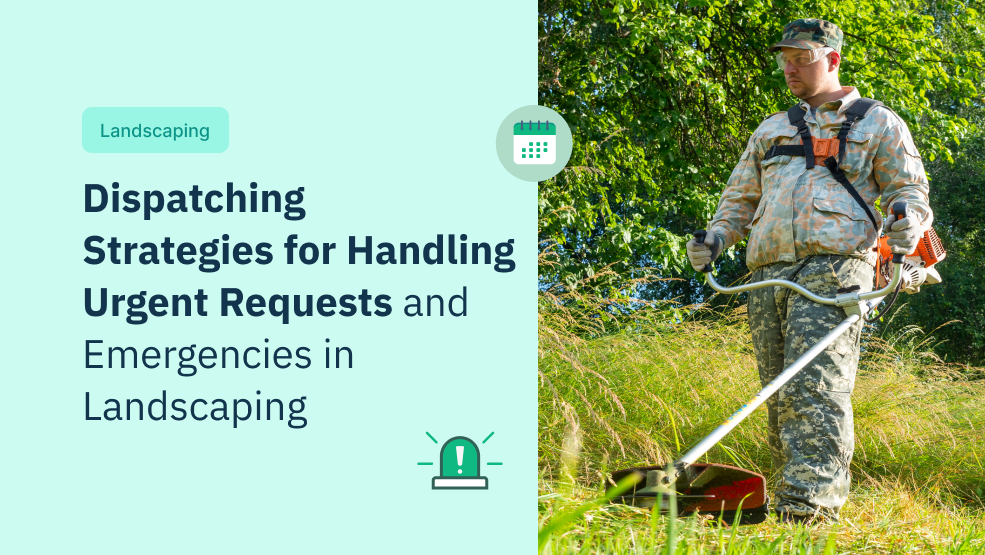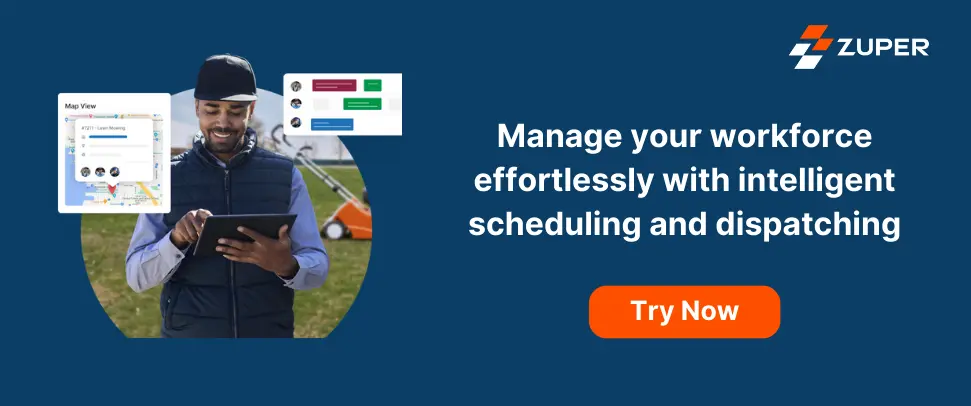As a dispatcher, your day revolves around scheduling and assigning calls to technicians and managing inventory. A dispatcher’s true skill lies in their ability to prioritize service requests, especially when dealing with a flood of last-minute calls. With little downtime, a dispatcher’s brain is constantly engaged in decision-making throughout the day.
Dealing with emergency requests and setting priorities appropriately is an ongoing problem for dispatchers in the landscaping sector. As a dispatcher using Zuper field service management software, this article will help educate you on how to efficiently route service calls and manage inventory effectively. There is no better way to streamline your workflow and improve customer service than by implementing FSM software—read on as we tell you why.
Master the triage dispatch process
The first strategy for handling emergencies in landscaping is mastering the triage process. As a dispatcher, when your phone rings, your heart races because you are the first line of defense in emergencies. How do you ensure the right help gets to the right place quickly? Given this huge responsibility, you need to first understand the level of emergency of every project. That is where the triage dispatch process comes in, helping you to become a master dispatcher
1. Understand urgency levels
Urgency levels in landscaping are like signals that help you understand how critical a situation is. You can set a color scheme based on the criticality of an issue. Red signifies an immediate need, such as a broken irrigation system or a fallen tree blocking a road. Yellow indicates urgency, but there’s some leeway, like a client’s request for additional services before an event. Green means it is not an emergency, such as regular maintenance or a consultation for future projects. Understanding these levels helps you prioritize tasks and allocate resources effectively.
2. Creating a decision tree for landscaping emergencies
Setting color bars is the most basic method of understanding urgency levels, A decision tree for landscaping emergencies is like a map that guides you through different scenarios based on the information you receive. You create a series of questions tailored to various situations (tree fallen, irrigation system issue, etc.) to determine the urgency and necessary actions. For example, “Is the tree blocking a road?” These questions help you decide the best course of action for each emergency.
3. Practicing for efficiency
When you have the decision tree ready, you need to start using it routinely–just as a skilled artisan perfects their craft. Work with your team to simulate different emergencies and see how quickly and accurately you can assess and respond. Time yourself to improve your response time. When you regularly practice will enhance your efficiency in handling landscaping emergencies.
4. Resource management
As a landscaping business operator, you’re like a general managing your troops. You have valuable resources like equipment, vehicles, and crew members. Triage helps you allocate these resources wisely by ensuring the right team is dispatched for each job. For example, you wouldn’t send a tree removal team for a routine maintenance request. By understanding the urgency and nature of the situation, you can ensure resources are used effectively.
5. Effective communication
Clear communication is crucial in landscaping emergencies. Once you’ve assessed the situation, communicate the urgency and details to your team clearly. This helps them understand what needs to be done and how to prepare. The more information you provide, the smoother and more effective the response will be. Clear communication can significantly impact the outcome of an emergency.
6. Reviewing operations
After each emergency response, take time to review and reflect. Was your triage process effective? Could communication have been improved? Analyzing each response helps you learn and improve your emergency management skills. Continuous review and improvement are essential for effective landscaping emergency management.
Develop key dispatcher skills
Skills! Certain skills are crucial for a dispatcher to make their work function efficiently. Here are eight skills a dispatcher in field service must possess to ensure smooth operations.
- Multitasking: Dispatchers juggle numerous tasks simultaneously. They field calls, schedule crews, manage project details, and address any issues that arise – all while ensuring everything runs smoothly. So, they must to skilled in multi-tasking without missing out on the details and quality. If two works are done simultaneously, both should be done perfectly without errors.
- Good problem-solvers: Unexpected situations pop up in landscaping. Emergencies! That is what we are discussing in this article. A skilled dispatcher can think on their feet, identify solutions quickly, and adjust schedules or crew assignments to keep projects on track. So, problem solving skills is essential for the dispatcher to handle urgent requests promptly.
- Organized and detail-oriented: Dispatchers are the backbone of any landscaping operation. They keep meticulous records, track inventory, and ensure all the necessary supplies and equipment are available for each crew. Their attention to detail guarantees projects run efficiently. So, the more organized a dispatcher is, less will be the confusion.

- Local area knowledge: Understanding the local area is crucial. Dispatchers familiar with the local community can factor in things like traffic patterns, permit requirements, and even weather forecasts when scheduling jobs. So, definitely having a local area knowledge is a head-on.
- Assertive and confident communicators: Dispatchers are the bridge between the company, crews, and clients. They should clearly communicate project details, expectations, and timelines to everyone involved. Their confidence fosters trust and ensures a smooth workflow. Assertive and confidence are skills they need to cultivate.
- Cheerleaders for the company: Enthusiastic dispatchers are a company’s greatest asset. They portray a positive company image and ensure crews feel valued and motivated, ultimately resulting in better service for you.
- Knowledgeable about services: A good dispatcher understands the landscaping services offered by the company. This allows them to accurately answer your questions, match your needs with the right crew, and ensure the crew has the expertise to handle your specific project.
- Quick learners and tech-friendly: The landscaping industry is constantly evolving. Dispatchers who are adaptable and comfortable with technology can learn new software, implement efficient scheduling tools, and effectively manage projects in a digital landscape.
Communicate clearly and listen to customers carefully
When communicating clearly and listening carefully during an emergency, here’s what you should aim to understand
1.Find the nature of the emergency
When dealing with a landscaping emergency, understanding the exact situation is crucial. Asking questions like “What happened to your landscaping?” or “What kind of assistance do you need for your yard?” helps determine the urgency and the appropriate response. This ensures that the landscaping team can quickly assess the issue and provide the necessary help.
2. Know the specific location
Knowing the specific location of the landscaping emergency is essential for a swift response. Details such as the address, nearest intersection, or landmarks near the affected area help the landscaping team locate the site quickly and efficiently. This ensures that the team can arrive promptly to address the landscaping emergency and prevent further damage.
3. Assess potential safety hazards
Assessing any immediate dangers related to the landscaping emergency is vital. Asking if there are injuries, fallen trees, broken branches, or other threats helps determine if the area needs to be cordoned off for safety. This ensures that the landscaping team can work safely and effectively to resolve the emergency without any further risks.
4. Client contact information
Obtaining the client’s name and phone number is essential for effective communication and follow-up. This allows the landscaping team to provide updates on the situation and coordinate any necessary actions. Additionally, having the client’s contact information enables the team to verify details if needed, ensuring that the response is tailored to the client’s specific needs.
Manage your time effectively
1. Prioritize your important tasks
In landscaping, your most significant tasks might include planning and executing major landscaping projects, such as installing a new garden or hardscaping features. These milestones are non-negotiable and must be completed to move your projects forward. Identify them first, and schedule tasks during your prime working hours, when you have the most energy and focus. For example, if you are designing a new garden layout, schedule this task for the morning when your creativity and concentration are at their peak. By prioritizing your most important jobs, you ensure that the most critical tasks are completed efficiently and effectively.
2. Prime time is morning
For landscapers, mornings can be the best time to tackle complex tasks like planting or heavy lifting. Your focus and concentration are often strongest in the morning, making it ideal for detailed work. Schedule your critical jobs , including tasks requiring deep thinking or physical labor, for these peak productivity hours. For instance, if you’re laying sod, plan to do this in the morning to take advantage of cooler temperatures and avoid the heat of the day. By scheduling your most demanding tasks for the morning, you can make the most of your energy and concentration levels.
3. Use task management applications
Task management tools can be invaluable for landscapers, helping you stay organized and on track. Use these tools to schedule your big rocks and other essential tasks, creating a clear roadmap for your workday. For example, you can use an app to schedule irrigation system checks or track plant deliveries. By utilizing task management applications, you can ensure that important tasks are completed on time and nothing falls through the cracks.
4. Minimize distractions
In landscaping, distractions can come in many forms, from noisy equipment to interruptions from clients or colleagues. Minimize distractions by finding a quiet workspace and turning off notifications on your phone. For example, if you’re working on a garden design, find a peaceful spot away from the hustle and bustle of the job site. By creating a distraction-free environment, you can focus more effectively on completing your high-priority tasks.
5. Schedule slots for emergency requests
While emergencies are a part of landscaping, you can manage them by allocating specific time slots in your schedule. For example, you might designate the last hour of each day for handling urgent requests. This ensures that you have dedicated time to address emergencies without completely derailing your planned workflow. By scheduling slots for emergency requests, you can respond promptly to urgent issues while still maintaining control over your schedule.
Get a flexible dispatch software solution
The next strategy is to acquire a dispatch software solution. Here’s the deal: productivity and efficiency in handling emergency services aren’t just a nice bonus—they are crucial. To supercharge your operations, you need advanced solutions like dispatch management software. We understand that you likely have many questions on your mind right now. Questions like, which dispatch software should you choose, and how beneficial is it for dispatch operations? Let us save you time and guide you to learn more about Zuper dispatch software. Below are a few reasons why you need dispatch software.
1. Automate the scheduling process
Scheduling field crews is one of the most challenging and confusing tasks for dispatchers. Issues like double booking, last-minute technician cancellations, and technicians stuck in traffic make scheduling a daily challenge. This complexity only increases during urgent service requests because you’re already juggling multiple tasks.
With dispatch software, you can automate the scheduling process. This means that when you receive an urgent service request, you can easily schedule the job for the technician or crew who are available nearby. Employee timesheets are well-recorded, helping you update the availability of technicians and their locations.
https://www.youtube.com/watch?v=Ap_ot0P0n502. Plan your routes better
Imagine you’ve implemented the strategies we discussed earlier, such as the triage process and decision-making tree. While these ensure that you categorize emergencies based on severity, quickly resolving these requests requires efficient route planning. Dispatch software helps you plan your routes better. You can easily create a route based on emergency requests with a simple drag-and-drop option on the map. Your fleet’s route will be ready in seconds.
But that’s not all—dispatch software also helps your crew reach their destinations more quickly and easily. When your fleet hits the road, they’ll encounter hindrances like traffic, narrow alleys, and construction. With dispatch software, especially Zuper, you have the option to choose between the shortest distance or the fastest travel time. A route will then be created based on your selection, allowing for seamless travel and quick customer reach.
3. Stay updated with real-time monitoring
Another challenge you might face is a lack of visibility once your fleet leaves. As a dispatcher, you may have no communication with them and no way to monitor their progress. If disputes arise, your only option is to call the crew every time for updates. This struggle ends with dispatch software, which comes with real-time monitoring and a comprehensive dashboard providing an overview of every operation. With real-time monitoring and communication tools, you can keep track of your team’s progress in the field without constant back-and-forth calls.
4. Keep your customers updated
Now, let’s consider your customer’s perspective. They have an emergency and request urgent service. You dispatch your team, but when they arrive at the customer’s door, the customer is clueless and anxious without any updates. Dispatch software solves this problem by providing customers with full visibility into the status of the job. They receive regular notifications, automated alerts, and an estimated time of arrival. No more shock or desperation while waiting for the team—your customers will know exactly when to expect you.
Emergency? Connect with Zuper
We hope you have found the easiest and most powerful solution to supercharge dispatch operations. Here is your opportunity to book a free demo of Zuper’s Dispatch Software product. Still hesitant? Learn more about our landscaping dispatch solution and take your next step toward success.
Step up and be a force for good. For every T-shirt you wear, over 700 gallons of water is consumed. You hold the power to reclaim gallons of water with every garment you wear. Choose minimalism; Save water. Mindful closet for a sustainable future!







